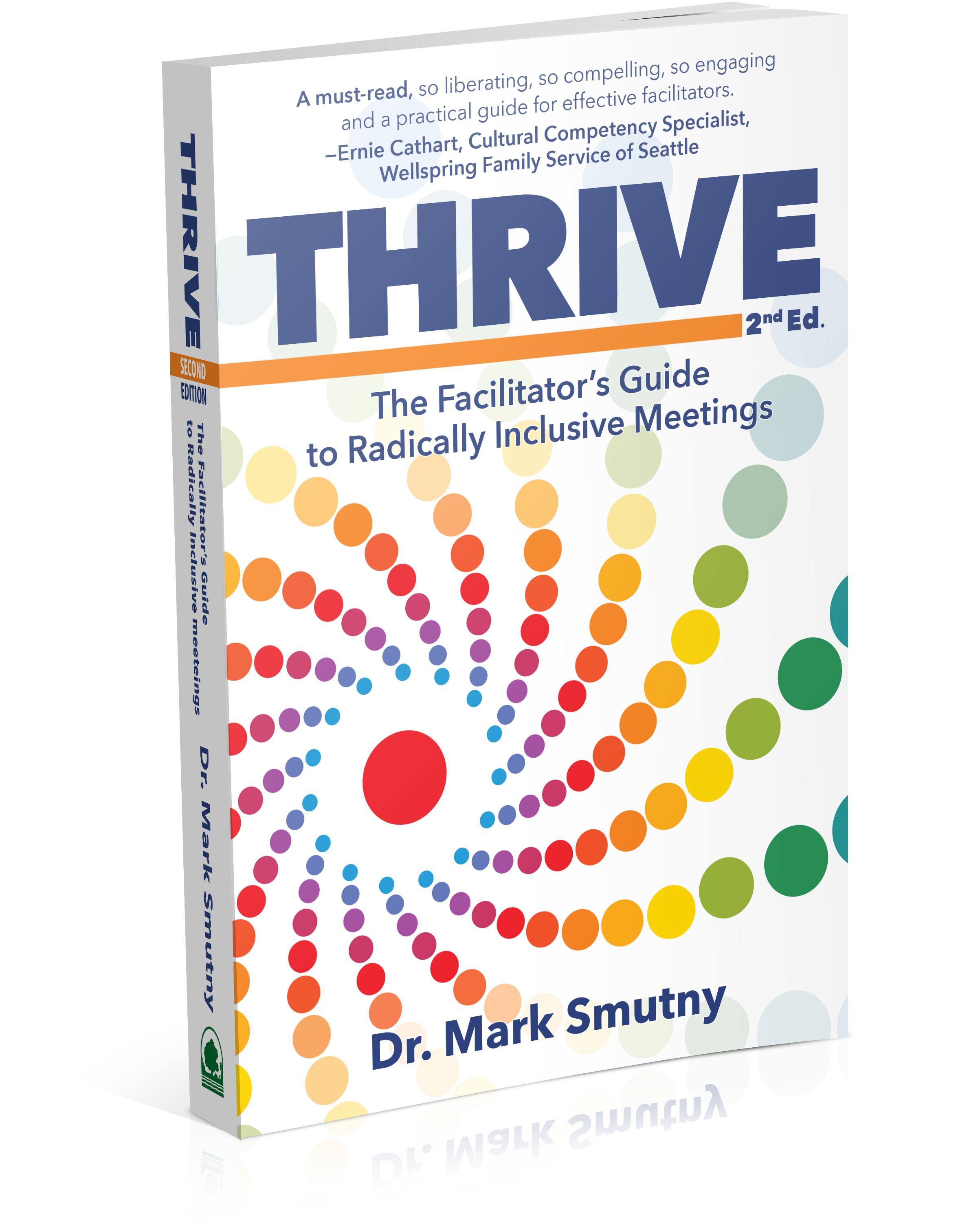Helping Nonprofits Thrive – Assembling a Facilitator’s Toolkit
By Dr. Mark Smutny – Author – Thrive: The Facilitator’s Guide to Radically Inclusive Meetings, 2nd ed.

Welcome to Helping Nonprofits Thrive. This weekly newsletter provides practical tools and a bit of theory to strengthen your inclusive leadership skills. Building inclusive and engaging practices that permeate every dimension of your nonprofit helps you stride toward the dream of diversity: better thinking, better results, and a better world.
Assembling a Facilitator’s Toolkit
You never know when you will need resources to make a meeting run well. I carry in my car a well-stocked, traveling toolkit for facilitating meetings on the spot. My Boy Scout leader taught me to “be prepared,” and prepared I am.
I cannot count the times I have attended a meeting and discovered the planners forgot to bring materials for recording results. I dig into my briefcase. Out come artist tape (better for walls than masking tape); brightly colored nontoxic, unscented markers; and my personal favorite—giant Post-it Notes.
My briefcase is heavy. Besides a worn copy of the Bible for my personal sustenance, I carry a laser pointer, a spare thumb drive, and a corkscrew. Hey, I never know when I’ll be called upon to facilitate a meeting or open a bottle of wine. Optional for the briefcase: a bottle of wine.
In my car, I keep large flip chart paper (24˝ x 36˝), a collapsible tripod, flower vases with artificial flowers, and a handful of brightly colored tablecloths. I have a large screen projector, extension cords and mini speakers in my office closet. I’m ready to go for the next facilitation gig. Assemble your own facilitator’s toolkit for your events. Be prepared!
Checklist
Here is a checklist of what you might need for your events. Some items will come from your stash. The hosting organizations will provide others. Some may need to be rented for the occasion.
- Digital camera for recording meeting results and photographing happy people. The photos (with permission) can be used to illustrate reports, enliven your website, and market future events.
- Laptop fully charged.
- A small speaker system. Today’s technology is amazing. Tiny speakers and a little amp hooked up to a laptop can belt it out. Very cool.
- Large screen Do not skimp on foot candles. Bright is beautiful.
- Microphone system. While usually provided by the hosting organization, take yours. Test the one provided for you before the meeting begins. Test all the electronic paraphernalia. Make sure they work. If they don’t work well, use your own.
- Extension cord and power.
- Screen or blank wall. If live captioning is provided, you will need two large screens.
- Round tables 36˝ to 48˝ Four tables will seat up to twenty people. An alternative is to rent tables. In a pinch, you can use eight-foot tables with two people on each side and no one on the ends. You want conversation and intimacy.
- Tables for refreshments. Rectangular tables work fine.
- Red and white checkered tablecloths, plastic or cloth. Other colors and patterns are fine.
- Colorful table runners from different cultures.
- Stuffed animals. Whether we are two years old or ninety‑two, stuffed animals are great when tensions mount.
- Name tags. Preprinted names work well if done in a large font. Otherwise, use blank name tags and encourage participants to write big!
- Flip chart paper, usually 24˝ x 36˝. I prefer the style with an adhesive strip.
- Tripod to hold the flip chart.
- White artist tape. Do not use masking or painter’s tape. They damage walls.
- Rolling whiteboards or a roll of butcher paper and a long wall or multiple flip charts.
- Giant Post-it Notes for collecting and posting key ideas. I love the 11˝ x 11˝ size. My second choice is 8˝ x 6˝. Smaller sizes cannot be read by eyes with sight impairment. Big and bold beats puny and paltry. Teach people to write big!
- Pencils and pens.
- Staples and stapler.
- Rubber bands.
- Screwdrivers, a small box of screws, scissors, pliers, small hammer and vise grips. Seriously.
- Duct tape–a facilitator’s best buddy. Use it for taping extension, microphone and computer cords to the floor and fixing everything except dinner.
- Nontoxic, unscented, colorful, broad‑tipped markers. Blue, green, dark brown, red, orange and black can be seen. Avoid light colors.
- Mugs or cups to hold markers and pens.
- Plastic vases with plastic flowers. Lots of them. We’re aiming for festive.
- Candles with batteries and a tiny light work well.
- First Aid kit.
- Facial tissues.
- A bell or chime to call I prefer a chime. Tibetan finger cymbals are also cool.
- Set a table with a combination of healthy and unhealthy choices: fruit, veggies, finger food, chips and what not. Include favorite beverages. Design the setup for people with mobility disabilities. Oh yes, chocolate!
- Cash for tips. You will want to thank custodians, chefs, waitstaff and parking attendants. Be generous.
- Business cards.
- A donkey. Carrying all this stuff can be taxing. A large suitcase with wheels also works.

More ideas for facilitating inclusive meetings.
For ideas on how to build inclusive meeting practices into your organization, check out my book Thrive: The Facilitator’s Guide to Radically Inclusive Meetings, 2nd ed. You may also visit my website at https://civicreinventions.com.
Send me an email about your ideas for building inclusion into meetings or share a particular problem you face at mark.smutny@civicreinventions.com. I will respond to each inquiry personally.
